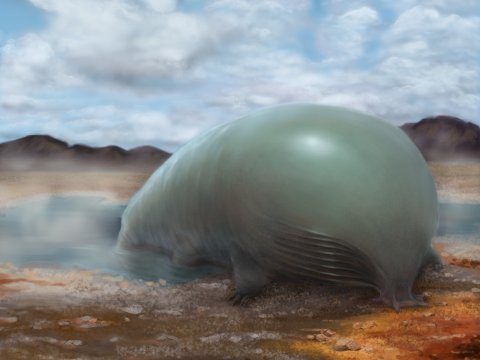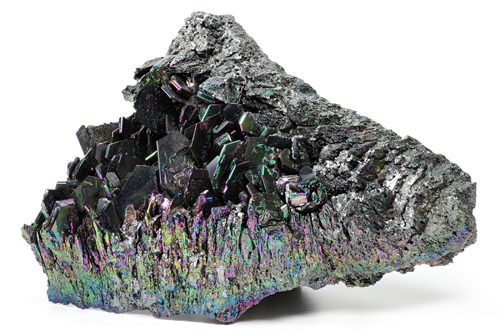
Scientists have coaxed life to do something it has never done before: bond silicon to carbon.You're probably already familiar with a few products products that use carbon-silicon, or organosilicon: glues, caulks, and pesticides, to name a few.

Scientists have coaxed life to do something it has never done before: bond silicon to carbon.
You're probably already familiar with a few products products that use carbon-silicon, or organosilicon: glues, caulks, and pesticides, to name a few.
But the new biological trick, which was forcefully evolved in bacteria, is safer and 15 times more efficient than synthetic, industrial chemistry at making organosilicons that are useful to industry and research.
This new bioengineering by Caltech researchers, described in the journal Science, may not improve the prospects of silicon-based alien life — contrary to a colorful illustration sent to members of the press (shown here) — but it could enable biologists to ask sci-fi-level questions.
"Why does life look the way it does? We can start asking, for the first time, what happens if you put silicon in place of carbon in living systems," Frances Arnold, a Caltech bioengineer and biochemist who co-authored the study, in a video about the work.
More immediately, the process could also revolutionize a whole class of chemistry that's useful in electronics, medicine, and other fields.
Silicon and carbon are remarkably similar — to a point

Silicon carbide crystals.
Silicon atoms outnumber carbon atoms in the Earth's crust more than 1,000-fold, yet the two elements are remarkably alike, chemically speaking. In fact, they're stacked right atop one another on the Periodic Table.
Yet life as we know it is organic, or based on carbon — from DNA to proteins to how it stores and uses energy. So why are we carbon-based and not silicon-based?
Chemist Raymond Dessy, in a 2010 Scientific American article titled "Could silicon be the basis for alien life forms, just as carbon is on Earth?", explored this question in detail. First, he explained how similar silicon and carbon are: They have the same number of electrons (four) available for bonding. They bond easily with oxygen. And they can link up to form polymers, or long chains of molecules, with oxygen — a foundation to making DNA and other genetic material.
But the similarities essentially end there.
When silicon is burned, it forms solids like silicon dioxide, better known as silica or quartz. Meanwhile, burning carbon compounds produces gases like carbon dioxide.
So silicon, at least in the environment of Earth, "would pose disposal problems for a living system," Dessy said, since waste products couldn't dissolve or float away. They'd instead stick around and accumulate.
Silicon-silicon bonds are also twice as weak as carbon-carbon bonds, which causes all sorts of problems as they are linked up (compared to carbon). And there's a more complex aspect here related to chirality or "handedness" of molecules. Silicon generally doesn't form unique versions of the same molecule, but carbon often does — and that chemical diversity gives life a lot of room to play.
"The complex dance of life requires interlocking chains of reactions. And these reactions can only take place within a narrow range of temperatures and pH levels," Dessy wrote. "Given such constraints, carbon can and silicon can't."
Still, we don't know this for sure. There might be some environments where silicon-based life might exist.
Organosilicons could help researches probe the details of why life is carbon-based, and perhaps if there may be a chance for a Star Trek-like "horta" creatures out there in the universe.
"It's very hard to explore that, chemically, unless you have organisms that can make these bonds," Arnold said in a video. "[But] we're not actually trying to find life in rocks, we're more trying to put rocks in life."
And doing so, Arnold said, could "promote new chemical reactions" that could help people on Earth.
Speeding up evolution and chemistry for industry
Lately, scientists have found organosilicons a key material in developing new medicine, since — as close-but-not-quite cousins to carbon — they mimic yet don't replace the stuff in our bodies, possibly aiding drug potency, release, and inhibition, as well as medical imaging technologies.
However: "No living organism is known to put silicon-carbon bonds together, even though silicon is so abundant, all around us, in rocks and all over the beach," Jennifer Kan, a researcher in Arnold's lab and the study's lead author, said in a Caltech press release.
As a result, we rely on synthetic chemistry to make organosilicons. And it's expensive, requiring rare or precious elements like rhodium, iridium, and copper — atoms that can catalyze, or speed up, a chemical reaction. Unfortunately, those reactions also require dangerous halogenated solvents (which form toxic gases when exposed to air).
So Arnold, Kan, and their colleagues found a way to hack nature to get the job done more cheaply and safely, using a relatively new process called directed evolution.
Directed evolution takes fast-growing bacteria (like Escherichia coli), mixes them with huge libraries of mutated genes (which might lend the bacteria new abilities), and shocks the mixture (to trick the bacteria into randomly incorporating the mutated genes). It then screens the billions of bacteria for the handful that do what researchers desire.
Altogether, it can take mere days to evolve microorganisms to do one's bidding.
Kan's team started with a bacteria called Rhodothermus marinus: an organism which lives in Icelandic thermal springs. The microbe has a well-studied, iron-based protein called "cytochrome c" which, the team discovered, could form carbon-silicon bonds.
After a bit of time in their evolutionary torture chamber, a strain emerged that could make organosilicon compounds 12 times more efficiently than ordinary cytochrome c. But they kept evolving the bacteria, focusing on the mutated bits of DNA that seemed to make a difference.
Ultimately they created a new bacteria species — and a new, triply-evolved version of cytochrome c — that could forge organosilicons 15 times more efficiently than "the best synthetic catalysts for this class of reaction," they wrote in the study. It also worked to build 20 different organosilicons, using different starting chemicals.
Since R. marinus is tough to grow (it requires scorching temperatures), they migrated their genetic masterpiece into E. coli, which is commonly grown in the lab. And it worked nearly as well.
"This iron-based, genetically encoded catalyst is nontoxic, cheaper, and easier to modify compared to other catalysts used in chemical synthesis," Kan said in the release. "The new reaction can also be done at room temperature and in water."
Hendrik Klare and Martin Oestreich, two chemists at Technische Universität Berlin who weren't involved in the study, wrote in a Science commentary that the study "closes a crucial gap between biological" and synthetic chemistry.
"The impact is unforeseeable, but it seems that we are a big step closer to potentially facilitating industrially relevant reactions," they wrote.
As for making possible blobby, silicon-based beasts that congregate around hot springs? Perhaps those are better left to Star Trek, and the imagination.